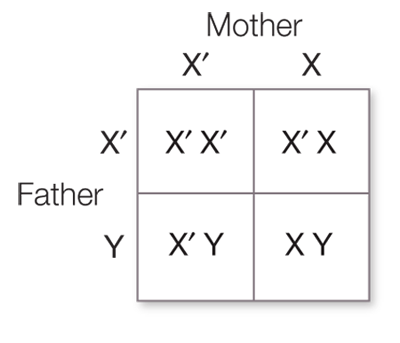recap
12.4 recap
Simple Mendelian ratios are not observed when genes are linked on the same chromosome. Linkage results in atypical frequencies of phenotypes in the offspring from a test cross. Calculating recombination frequencies between genes can lead to a genetic map of the genes. Sex linkage in humans refers to genes on one sex chromosome (usually the X) that have no counterpart on the other sex chromosome.
learning outcomes
You should be able to:
Describe evidence that genes on the same chromosome are linked.
Use a model to illustrate how recombinant frequencies relate to gene locations on a chromosome.
Analyze data involving gene linkage.
Analyze data involving sex-
linked genes. Construct a diagram to illustrate differences between sex-
linked and autosomal genes.
1.
Describe the concept of genetic linkage and its implications in genetic crosses.
In genetic linkage, alleles on the same chromosome are generally carried together when a gamete is formed. That is, if in a heterozygote AaBb the A and B are on the same chromosome (and a and b on the other chromosome), gametes will be AB or ab.
2.
Using a diagram of a chromosome, illustrate how the physical distance that separates genes on a chromosome affects their recombination frequency.

3.
Use a Punnett square to show why red-

4.
How does a sex-
A sex-
5.
Sometimes scientists get lucky. Consider Mendel’s dihybrid cross shown in Figure 12.4. Peas have a haploid number of seven chromosomes, so many of their genes are linked. What would Mendel’s results have been if the genes for seed color and seed shape were linked with a map distance of 10 units? Now, consider Morgan’s fruit flies (see Figure 12.17). Suppose that the genes for body color and wing shape were not linked. What results would Morgan have obtained?
The cross RRYY × rryy produces RrYy (round, yellow) F1 offspring. If the seed shape and seed color genes were linked with no recombination between them, the F2 would also be all RrYy. A distance of 10 map units between two genes means that on average 10% of the F2 offspring will have recombinant phenotypes, in this case round green (5%) and wrinkled yellow (5%).
6.
In Drosophila, three autosomal genes have alleles as follows:
Gray body color (B) is dominant over black (b).
Normal wings (VG) is dominant over vestigial (vg).
Red eye (R) is dominant over sepia (r).
Two crosses were performed, with the following results:
| Cross I: | Parents: heterozygous red, normal × sepia, vestigial | |
| Offspring: | 131 red, normal | |
| 120 sepia, vestigial | ||
| 122 red, vestigial | ||
| 127 sepia, normal | ||
| Cross II: | Parents: heterozygous gray, normal × black, vestigial | |
| Offspring: | 236 gray, normal | |
| 253 black, vestigial | ||
| 50 gray, vestigial | ||
| 61 black, normal | ||
Are any of the three genes linked on the same chromosome? If so, what is the distance between the linked genes (in map units)?
The cross in Figure 12.19 is BbVgvg (gray, normal) × bbvgvg (black, vestigial). If there were no linkage between the genes, then the gray, normal parent would produce four types of gametes: BVg, bVg, Bvg, and bvg. When these combine with the bvg gametes produced by the other parent, four types of offspring in a 1:1:1:1 ratio will result: BbVgvg (gray, normal), bbVgvg (black, normal), Bbvgvg (gray, vestigial), and bbvgvg (black, vestigial).
The body color (G/g) and wing size (A/a) genes are linked; eye color (R/r) is unlinked to the other two genes. The distance between the linked genes is 18.5 units.
The genes we’ve discussed so far in this chapter are all in the cell nucleus. You might be surprised to learn that other organelles, including mitochondria and plastids, also carry genes. What are these genes, and how are they inherited?